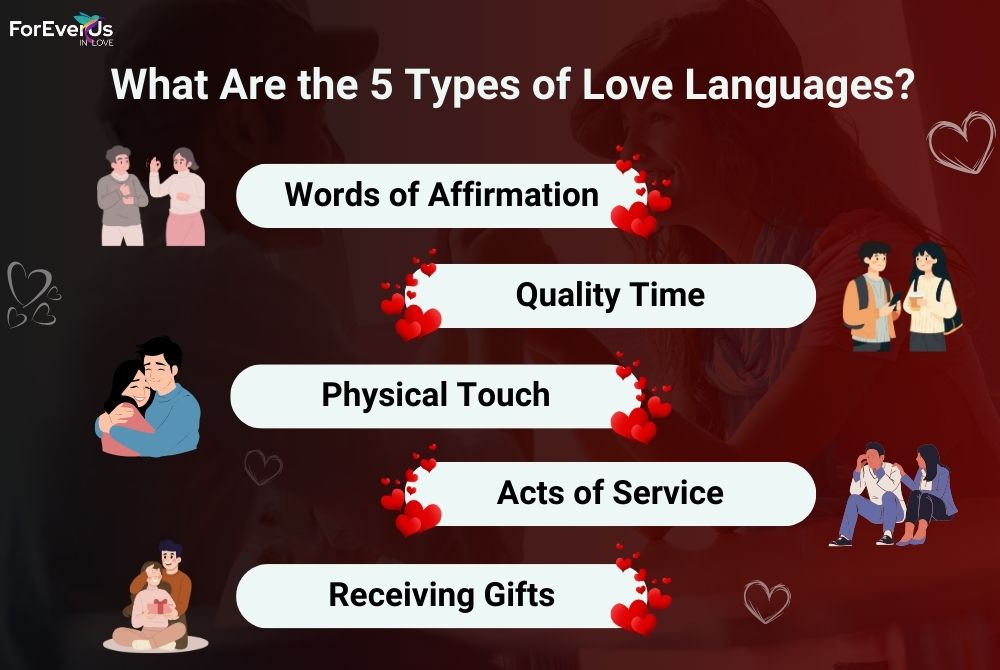Have you ever felt like you’re giving your best in a relationship, but your partner still doesn’t feel loved? Or maybe you’ve wondered why your partner’s small gestures mean so much to them while your way of expressing love goes unnoticed.
The truth is—love isn’t just about how much you care; it’s about how you show it.
Dr. Gary Chapman’s theory of the Five Love Languages has transformed the way people understand emotional needs in relationships. Each person has their own unique way of giving and receiving love, and understanding these love languages can create stronger, deeper connections.
In this guide, you’ll learn:
- What Is a Love Language?
- What Are the Love Languages & How They Work (With Examples)?
- Why Do People Speak Different Love Languages?
- How to Discover Your Love Language?
- Key Questions to Ask Yourself for Identifying Your Love Language
- How Can the 5 Love Languages Transform Your Relationship?
- How to Apply Love Languages in Long-Distance Relationships?
- Common Misunderstandings About Love Languages?
Let’s dive in!
What is a Love Language?
A love language is the way people prefer to give and receive love in relationships. It’s how you express affection and feel most appreciated by your partner.
Dr. Gary Chapman introduced this concept in his book The 5 Love Languages, explaining that understanding your partner’s love language helps build a stronger emotional connection.
Think of love languages like different dialects—if you’re speaking in one and your partner in another, both of you might be expressing love without fully understanding each other. Learning your partner’s love language helps bridge that gap and ensures your love resonates with them.
What Are the 5 Types of Love Languages & How They Work (With Examples)?
According to Dr. Chapman, there are five universal love languages types:

Let’s explore each love languages types with examples.
1. Words of Affirmation
People with this love language value spoken or written words of love and appreciation. Compliments, words of encouragement, and sweet messages mean the world to them.
What It Includes:
- Verbal compliments and praise
- Written notes of appreciation
- Regular expressions of “I love you”
- Recognition of achievements
- Words of encouragement
Example: Sarah feels happiest when her partner, Mark, sends her sweet texts throughout the day or praises her after a long workweek.
How It Strengthens Relationships:
- Helps partners feel emotionally supported
- Builds confidence and self-worth
- Reduces misunderstandings caused by lack of verbal affirmation
Pro Tip: Leave sticky notes with small compliments in unexpected places—your partner will appreciate the gesture more than you think!
2. Quality Time
This love language is all about giving your partner undivided attention. It’s not just about spending time together—it’s about making that time meaningful.
What It Includes:
- Uninterrupted conversations
- Shared activities without distractions
- Active listening with eye contact
- Regular dedicated time together
- Shared recreational pursuits
Example: Emma feels closest to John when they have deep conversations over a cozy dinner at home.
How It Strengthens Relationships:
- Builds emotional intimacy and connection
- Helps both partners feel valued and prioritized
- Reduces feelings of neglect or disconnection
Pro Tip: Put your phone away and give your partner 100% attention during conversations—even if it’s just for 20 minutes.
3. Physical Touch
For some, physical touch is the ultimate way to feel loved. From simple gestures like holding hands to warm hugs, touch plays a vital role in making them feel secure.
What It Includes:
- Holding hands
- Embracing
- Casual touching during conversation
- Physical proximity
- Thoughtful physical gestures
Example: When Alex hugs Sarah after a stressful day, it instantly makes her feel safe and loved.
How It Strengthens Relationships:
- Creates a sense of closeness and warmth
- Helps partners feel safe and secure
- Reduces stress and promotes physical well-being
Pro Tip: Small, unexpected touches can be just as meaningful as grand romantic gestures.
4. Acts of Service
Actions speak louder than words for people who resonate with this love language. They appreciate when their partner helps make life easier.
What It Includes:
- Helping with tasks
- Taking on responsibilities
- Anticipating needs
- Practical problem-solving
- Supportive behaviors
Example: Jake makes breakfast for Emily on a busy morning—without her asking. That small gesture makes Emily feel seen, cared for, and deeply loved.
How It Strengthens Relationships:
- Creates a sense of partnership and teamwork
- Shows thoughtfulness and effort
- Reduces stress and makes daily life smoother
Pro Tip: Ask your partner, “What’s one thing I can do this week to make your life easier?”
5. Receiving Gifts
This love language isn’t about materialism—it’s about the thought behind the gift. A meaningful present, no matter how small, can make someone feel cherished.
What It Includes:
- Thoughtful presents
- Symbolic tokens
- Handmade items
- Meaningful mementos
- Surprise gestures
Example: Alex surprises his partner with her favorite chocolate bar after a long day—not because she asked, but because he knows it makes her happy.
How It Strengthens Relationships:
- Reinforces emotional connection through thoughtful gestures
- Makes the receiver feel appreciated and remembered
- Provides physical reminders of love and affection
Pro Tip: The best gifts don’t have to be expensive—focus on meaningful and personal gestures!
Why Do People Speak Different Love Languages?
Everyone develops their love language based on childhood experiences, personality, and emotional needs.
For example:
- If your parents showed love through kind words, you might value Words of Affirmation.
- If your family prioritized helping each other out, Acts of Service might be your primary love language.
These preferences aren’t random—they’re deeply rooted in your emotional blueprint. If you’re struggling with insecurities in your relationship, learning each other’s love language can help strengthen your bond.
How to Find Your Love Language?
Figuring out your love language can be a game-changer in how you give and receive love. Here’s how you can find yours:
✔ Reflect on What Makes You Feel Most Loved – Think about moments when you’ve felt truly appreciated. Was it through words, actions, time spent together, gifts, or touch?
✔ Observe How You Express Love to Others – The way you naturally show love is often the way you want to receive it.
✔ Take the Official Love Language Quiz – A structured quiz can help pinpoint your primary and secondary love languages.
Key Questions to Ask Yourself for Identifying Your Love Language
Here’s a quick guide to help you determine which love language resonates with you the most.
Questions Regarding Words of Affirmation
- Do kind words and compliments make you feel deeply appreciated?
- Do you enjoy hearing “I love you” frequently?
- Do you feel hurt when your partner doesn’t express appreciation verbally?
Questions Regarding Quality Time
- Do you feel most connected when you have someone’s full attention?
- Do you love deep conversations and uninterrupted time together?
- Do you get frustrated when your partner is distracted while spending time with you?
Questions Regarding Physical Touch
- Do hugs, hand-holding, or cuddling make you feel safe and loved?
- Do you naturally reach out to hold hands or show affection through touch?
- Do you feel disconnected when there’s a lack of physical affection?
Questions Regarding Acts of Service
- Do you feel most loved when someone helps you with tasks without being asked?
- Do you often express love by doing things for others?
- Do you get frustrated when your efforts to help go unnoticed?
Questions Regarding Receiving Gifts
- Do thoughtful gifts (big or small) make you feel loved and valued?
- Do you enjoy giving meaningful presents as a way to show love?
- Do you feel disappointed when special occasions pass without a gift?
Understanding your love language—and your partner’s—can strengthen your relationship by making sure you both feel truly appreciated.
How Can the 5 Love Languages Transform Your Relationship?
When you and your partner start communicating love in the way that resonates most, your relationship can become:
- More emotionally fulfilling
- Less prone to misunderstandings
- Stronger during tough times
It’s like learning your partner’s “love dialect”—a way to connect on a deeper level!
How to Apply Love Languages in Long-Distance Relationships?
Being in a long-distance relationship doesn’t mean you can’t express love effectively — it just takes a little creativity.
Here’s how to express each love language from a distance:
✔ Words of Affirmation – Send daily voice notes or handwritten letters.
✔ Acts of Service – Arrange a surprise food delivery for your partner.
✔ Receiving Gifts – Mail them a thoughtful care package.
✔ Quality Time – Plan virtual date nights or watch a movie together online.
✔ Physical Touch – Talk about future visits and express affection through video calls.
Common Misconception About Love Languages
- “My partner should just know my love language.” – Love isn’t mind-reading! Open communication is key.
- “If our love languages don’t match, we’re incompatible.” – Love languages can be learned and adapted over time.
- “I only have one love language.” – Most people have a mix of two or more.
Final Thoughts
Love isn’t just about feeling—it’s about expressing it in a way that truly reaches your partner’s heart. By understanding love languages, you’re not just improving your relationship; you’re unlocking a whole new level of emotional connection.
Love is a language—the key is to learn how to speak it fluently. At ForeverUs In Love, we believe that strong connections start with understanding each other. Our online dating platform is designed to help couples build meaningful relationships, and with our app launching soon, you’ll have even more ways to connect on a deeper level!
Take a moment to think about your own love language. What makes you feel the most cherished? How does your partner express love? The more you learn, the easier it becomes to create a relationship where both of you feel valued, appreciated, and deeply understood.
So, why not start today? Try speaking your partner’s love language and see the difference it makes!
FAQs
What happens if my partner and I have different love languages?
It’s normal to have different love languages. The key is to make an effort to express love in ways your partner understands, leading to better communication and a stronger connection.
Can I have more than one love language?
Yes, most people have a mix of love languages. You might have one primary language and a secondary one, which both contribute to how you feel loved.
How can I discover my partner’s love language?
Pay attention to how your partner expresses love and reacts to different gestures. You can also take the official love language quiz together to better understand each other.
Do love languages change over time?
Yes, love languages can change as life circumstances evolve. It’s important to stay open and check in with your partner to adapt to each other’s shifting needs.
What are primary and secondary love languages?
Primary love language is the main way you feel most loved, while secondary love language supports it by adding more emotional connection to your relationship. Both are shaped by childhood experiences and personal values.
Do cultural differences affect love languages?
Yes, cultural backgrounds can shape how people express love. For example, Acts of Service is valued in many Asian cultures, while Physical Touch is common in Latin cultures. Understanding these differences helps in cross-cultural relationships.
Are some love languages more compatible than others?
Any love language combination can work with mutual effort. Some may naturally align, like Quality Time and Physical Touch, but the key is learning and respecting your partner’s love language.












